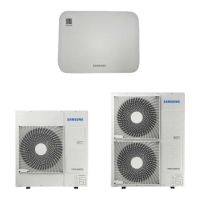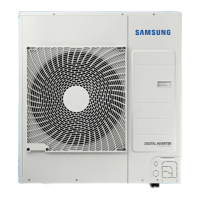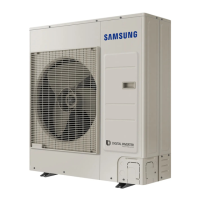How to fix E221 error on Samsung AC024BNHDCH?
- Jjohn90Aug 17, 2025
To resolve the E221 error on your Samsung Air Conditioner, check the outdoor sensor for open or short circuits.
How to fix E221 error on Samsung AC024BNHDCH?
To resolve the E221 error on your Samsung Air Conditioner, check the outdoor sensor for open or short circuits.
How to troubleshoot E231 error on Samsung AC024BNHDCH?
To troubleshoot the E231 error on your Samsung Air Conditioner, check the Cond-Out sensor for open or short circuits.
What to do if my Samsung AC024BNHDCH Air Conditioner shows E202 error?
If your Samsung Air Conditioner displays the E202 error, it is recommended to check the electrical connection and settings between the indoor and outdoor units.
What does E121 mean on my Samsung Air Conditioner?
The E121 error code on your Samsung Air Conditioner indicates an issue with the indoor unit's room thermistor, specifically an open or short circuit. Check the room temperature sensor of the indoor unit to see if it is shorted or open.
What to do if my Samsung AC024BNHDCH shows error code E201?
If your Samsung Air Conditioner displays error code E201, it indicates a communication tracking failure after the initial power is supplied. The suggested solution is to check the indoor quantity setting in the outdoor unit.
What does E122 mean on a Samsung Air Conditioner?
The error code E122 on your Samsung Air Conditioner indicates that the indoor unit EVA_IN thermistor is open or shorted. Check the EVA IN sensor of the indoor unit to determine if it is shorted or open.
What does E123 mean on my Samsung AC024BNHDCH Air Conditioner?
The E123 error on your Samsung Air Conditioner means that the indoor unit EVA_OUT thermistor is either open or shorted. You should check the EVA OUT sensor of the indoor unit to see if it is shorted or open.
What does E153 mean on Samsung Air Conditioner?
The E153 error code on your Samsung Air Conditioner indicates that the indoor unit float switch is open or shorted, or there is a drain pump operation issue. Check the float switch for a second detection.
What does error E198 mean on Samsung AC024BNHDCH Air Conditioner?
The E198 error code on your Samsung Air Conditioner indicates that the thermal fuse is open. You should check the indoor unit terminal block.
What to do if Samsung Air Conditioner displays E322 error?
If your Samsung Air Conditioner displays the E322 error, check the ESC OUT sensor for open or short circuits.
Warnings regarding electrical shock, damaged parts, and grounding.
Safety and environmental considerations for refrigerant release and handling.
Safety measures for welding air conditioner pipes, including refrigerant removal.
Step-by-step guide for disassembling the panel and filter of 1Way CST indoor units.
Continuation of indoor unit disassembly, focusing on grille, clip wire, and connectors.
Steps for removing step motor, hinges, sensors, and guide air components.
Procedures for separating connectors on the PCB and the drain sub.
Steps for removing screws from heat exchanger, indoor sensor, and fan motor cover.
Procedures for separating cross fan, drain pump, and drain hose.
Disassembly steps for panel and filter of 1Way CST AC018BN1DCH model.
Procedures for opening the grille, detaching clips, removing screws, and separating the panel.
Steps for separating the panel, drain pan screws, hooks, and caution for heat exchanger board.
Procedures for removing screws from electrical parts, disconnecting connectors, and separating them.
Procedures for removing screws from heat exchanger, separating sensors, EEV connector, and expansion coil.
Procedures for opening the panel, detaching safety clips, removing screws, and disconnecting wires.
Steps for disassembling panel bolts, steel hangers, and control box screws.
Procedures for unscrewing bell-mouth and drain pan screws.
Procedures for pulling hooks, detaching safety clips, removing screws, and disconnecting wires.
Steps for removing hinge-blade, cover display, and cover PBA.
Procedures for removing humidity sensor, cover motor screws, and step motor.
Steps for disconnecting connectors, removing ground screw, and separating control box.
Procedures for unscrewing bell-mouth and drain pan screws.
Procedures for disassembling ceiling type panels, including screws and hooks.
Steps for rotating grille, removing safety clips, and control box screws.
Procedures for removing control box screws, pulling covers, and avoiding hooks.
Steps for separating connectors, removing ground screw, and separating top cover.
Steps for removing screws from drain pump, separating drain hose.
Procedures for removing hex nuts from fan motor, separating motor wires, and cross fan.
Steps for unfastening evaporator screws, holder pipe, bracket-evap, holder evap, and fixing earth screw.
Procedures for loosening holder motor screws, unfastening screws, and pulling motor fan and cross fan.
Guide for diagnosing issues using test operation modes and display indications.
Explanation of test operation modes (K1, K2, K3) and display indications.
Detailed table of display contents for different test modes (SEG1-SEG4).
Procedures for version check and address setting using K4 short and long push.
Guide for manually setting outdoor unit options and addresses via the remote.
Step-by-step guide for performing the Auto Check self-diagnosis function.
List of indoor unit error codes and corresponding LED display patterns.
Detailed causes and measures for indoor unit errors, including product operation with error.
Table of abnormal conditions and LED lamp display for 4way Cassette (600x600).
Table of abnormal conditions and LED lamp display for 1way Cassette models.
Abnormal conditions and indicator status for Home Duct and Duct S units.
List of abnormal conditions and error codes for RAC (AC***BNADCH) units.
List of abnormal conditions and error codes for RAC (AC***BNTDCH) units.
Abnormal conditions and LED display for Console (AC***BNJDCH) units.
Troubleshooting for float switch errors, EEPROM errors, and incompatible indoor units.
General section for troubleshooting symptoms.
Troubleshooting steps for E121 error, including checking connections and resistance.
Troubleshooting for E122/E123 errors, checking sensor connector, resistance, and PCB.
Troubleshooting steps for E153 error, checking water level, drain pump, and PCB.
Troubleshooting for E154 error, checking motor connector, rotation, voltage, and PCB.
Troubleshooting for E162 error, checking EEPROM assembly, soldering, and replacing PBA.
Troubleshooting for E202 error, checking PCB response, communication wires, and PCB.
Initial diagnosis steps for outdoor unit power issues, checking connections and power parts.
Further diagnosis for outdoor unit power issues, checking power parts and fan motor connector.
Troubleshooting communication errors between indoor and outdoor units, checking wires and PCBs.
Measuring communication IC and TVS-Diode for communication errors.
Troubleshooting communication errors between outdoor unit INV and Main MICOM, checking power and PCB.
Troubleshooting for outdoor sensor errors, checking connectors, resistance, and PCB.
Troubleshooting for E403 error, checking indoor fan/motor, heat exchanger sensor, and air inlet.
Troubleshooting for E422 error, checking service valves, piping, EEV, and sensors.
Troubleshooting for outdoor fan errors, checking power, connectors, resistance, and PCB.
Troubleshooting for compressor starting issues, checking power, wiring, resistance, and noise.
Continued troubleshooting for compressor errors, checking wires and PCB replacement.
Troubleshooting for current errors, checking installation, obstacles, and PCB.
Troubleshooting for IPM over current errors, checking installation, wiring, and PCB.
Continued troubleshooting for IPM errors, checking service valve, compressor wires, and temperature sensor.
Further troubleshooting for IPM errors, focusing on compressor wire connections and PCB replacement.
Troubleshooting for DC LINK errors, checking power connection, fuses, reactor, and terminal block.
Continued troubleshooting for DC LINK errors, checking terminal block screws and power wire connections.
Troubleshooting for gas leakage errors, checking installation, service valve, EVA sensor, and refrigerant.
Continued troubleshooting for gas leakage, checking installation, service valves, and refrigerant.
| Brand | Samsung |
|---|---|
| Model | AC024BNHDCH |
| Category | Air Conditioner |
| Language | English |












